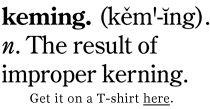Idea: A new automatic setting for cameras
There’s a rule of thumb for long lenses and shutter speeds: to handhold a camera without noticeable motion blur, your shutter speed should be no slower than the inverse of your focal length. So for a 50mm lens, you can safely handhold at 1/50 of a second or faster. If you have a long telephoto, like say a 200mm lens, you shouldn’t try to handhold at slower than 1/200 of a second.
But what if you’re using a zoom lens, and your focal length varies from one shot to another as you capture wide shots and close-ups to tell the story of whatever you’re shooting? Wouldn’t it be great if your camera had a setting to automatically adjust your shutter speed (and appropriately your aperture to maintain exposure) when you zoom so your tight shots are still nice and sharp?
You already have an aperture priority mode that adjusts your shutter speed if you change the aperture, and a shutter priority mode that does the opposite. So why not add focal length to the automatic equation, too?
It will not be useful in all situations, of course. In dim light, your lens might not be able to open up enough to compensate for the loss of light when the shutter speed increases as you zoom. But in other situations, this setting could be just the thing that keeps you taking sharp photos instead of smeary messes.












Comments
All DSLRs already do this. The focal length being used is taken into account when the camera makes it’s exposure calculations.
Posted by: Josh | February 18, 2014 7:28 PM
I don’t think that’s really true except for lenses where the aperture has to change as you zoom. So for example you might have a lens that opens to f/1.2 at 24mm but is only able to open to f/5.6 at 200mm. In that case, if you’re shooting wide open and you zoom, your aperture will close and your camera might change the shutter speed to make up for the lost light.
But if I’m using a lens where the aperture remains the same no matter how much I zoom, the exposure calculation should be the same at any focal length.
But I’d like to set my camera to 1/25 at 24mm and have it automatically change it to 1/200 when I zoom into 200mm (and compensate for lost light by opening the aperture).
I’ve heard some feedback on Twitter that the P or Program mode of a DSLR can do this. But I’m not entirely sure. In 20 years of shooting I’ve never actually used the P mode. I assumed P took over more control and made more of the decisions for you than that. Can anyone verify if you can really use P to do this? Can you set your own speed and aperture for one focal length and have it adjust appropriately just because you zoom (when the exposure is still the same throughout the zoom)?
-David
Posted by: David | February 18, 2014 8:28 PM
David: the P mode will set both shutter and aperture for the designated ISO and exposure you want. However, since there are multiple pairs of shutter+aperture that will satisfy the exposure desired, you can switch between them easily with one of the dials. (at least, on my Canons. I’m not familiar with Nikon)
btw, P mode is one of my favourites to shoot casually with, probably because it’s a feature I grew up with - my first camera as a teen was the Canon AE-1Program - the first(?) Canon with that setting :)
Posted by: Nemo | February 18, 2014 10:26 PM
Yup, Program mode tries to do this, among other things, or it does for Canon, at least. I’ve been using “P” more since attending a course about my camera, and that’s certainly my experience, anyway.
However, I would like more control over it. I have slightly shakier hands than the average human (a harmless “inherited tremor”, according to a neurologist I saw), so I’d like to be able to set the rule as 1/(2*focal length), e.g. set 1/100th of a second for a 50mm lens, which is what seems to work for me.
(You can work around it a bit, as “P” lets you adjust the shutter speed up or down from its initial guess, moving the aperture to compensate, or vice versa, but it’s slightly fiddly.)
Posted by: Matt Gibson | February 19, 2014 4:15 AM
my Nikons do this, as my Panasonic µ43s. and both in A (Av) with Auto-ISO, too. but despite all the modern magic sometimes i still use M, maybe to feel nostalgic. (or might be the remote flashes).
Posted by: grubernd | February 20, 2014 4:56 AM